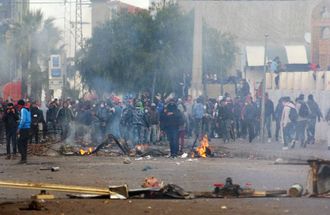Collapse of the Helsonian Union
 Riots in Kúri, August 2005 | |
| Date | July 31 – September 8, 2005; 18 years ago |
|---|---|
| Location | Helsonian Union |
| Participants | Helsonian Government Parliaments of the USHR Democratic Resistance |
| Outcome | Fall of Kúúlism in Terminia Dissolution of Helsonia into 6 independent republics |
| Part of a series on the |
| Helsonian Union |
|---|
 |
The collapse of the Helsonian Union occurred between 31st July and 8th September 2005. It was a result of years of civil unrest and anti-Kuulist sentiment, set in motion in 1999 by a coup which put an unpopular, authoritarian regime into power. This reversed decades of popular liberal reforms which had been implemented under the leadership of Jáán Vexut. As a result, the federal government was unable to exercise control over the nation, and was unable to prevent the secession of Amerhan in July, the occupation of West Utol by [COUNTRY] in August, and ultimately the splinter of the Kúúlist People's Party in September.
Anti-Kúúlist factions of the KPP, which had in 2000 been able to amass a majority in the Supreme Parliament (largely due to a disregard for the legislature by the authoritarian regime), revolted against the ruling statists and appointed the populist opposition figurehead Váázegy Groz to lead a provisional government overseeing a transition to capitalism and democracy. On the evening of 8th September 2005, the Helsonian flag was lowered over Kúri for the last time and replaced with the green opposition pennant.
Following the collapse, the Statists managed to cling to power in East Utol, while the newly independent republics of Terminia Minor, East Terminia, and West Terminia agreed to reinstate a federal government which would become Cerman. The 2006 invasion of Utol by Cerman effectively reduced the number of de facto Helsonian successor states from five to just two - Cerman and Amerhan - however it remains the objective of the Cermani government and several Amerhani political parties to reunite.
1999
Coup of 1796
In December 1999, the popular leadership of Jáán Vexut, which had succeeded on a platform of liberalisation since 1977, was abruptly brought to an end when members of the authoritarian wing of the KPP, supported by the military, put Vexut under house arrest and performed a purge of liberals from the Helsonian government. Despite a period of passive resistance and general strikes encouraged by Vexut, the coup was successful, and in a period of three days most important government buildings, including the Supreme Parliament, had been stormed by supporters of the coup.
The coup leaders bypassed provisions in the Helsonian constitution and stripped the legislature and the KPP of almost all of its power, returning the USHR to a de facto dictatorship as had been the case in the 1940s and 50s. These developments were widely denounced by regional leaders, members of the parliament, and international observers, and in response the USHR was expelled from several international organisations and suspended from United Sahar.
2000
West Utol
Rural areas were badly affected by the strikes, and in early 2000 West Utol (which had been forcefully incorporated into the Helsonian Union following the Great Ekuosian War) began to push for independence and reintegration into [COUNTRY]. In response, the Helsonian Union launched a full-scale military deployment in "volatile" regions, hoping to dissuade other regions from pushing for similar objectives. Various skirmishes in Utol resulted in at least 20 civilian casualties and many more injuries, and exacerbated the unpopularity of the new regime.
Again, these actions were met with international denouncement and sanctions, including cutting Helsonia off from many vital natural resource imports.
Justice Square riots
In a further crackdown on political opposition, 127 prominent members of the KPP were tried and sentenced for counterrevolution, including Vexut himself who was exiled to Terminia Minor. The judiciary had been filled with supporters of the regime in order to ensure the outcome was as predicted.
These sentencings led to a mass protest outside the Supreme Court in Kúri, which continued for three days in June, until armed police forcibly dispersed the protest in a state-sanctioned display of police brutality. The demonstrations started on the morning of the 3rd June 2000, with 300 to 400 students gathered in Justice Square protesting the jail sentences and fines which were being given to politicians that had previously been popular liberal reformers. The number of protesters swelled to around 10,000 as more and more students joined the protest, which led to an emergency session of the KPP leadership. Metropolitan policemen and secret police were ordered to cordon off the area and videotape protesters.
On the second day, the situation escalated as clashes between police and protesters turned into a wide-scale confrontation. Troops and anti-riot police were deployed, but the clashes could not be brought under control until the 6th June. Official numbers published by the Helsonian Union estimated the protest had drawn 8,000 people, while estimates by the Ekuosian Union placed the figure closer to 30,000 protesters and 300 fatalities or executions thereafter.